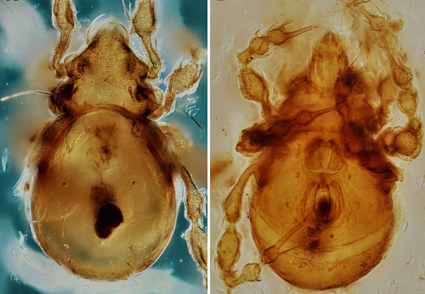Abstract
Two closely related species of the genus Piribelba (Oribatida, Damaeidae) are redescribed based on morphology of adults and developmental instars. Redescription of P. rossica (Bulanova-Zachvatkina, 1957) is based on specimens collected in Russia, including specimens identified by Bulanova-Zachvatkina; redescription of P. piriformis (Mihelčič, 1964) is based on specimens collected in Europe, including Mihelčič’s types. COX1 sequence barcoding of P. piriformis and P. rossica indicated that they are distinct species, having 12.0% uncorrected p-distances and 13.3% Kimura two-parameter distances (K2P). Based on the morphological and genetical differences, the synonymy of P. rossica and P. piriformis is rejected. A key to known species of Piribelba is provided.
References
Bayartogtokh, B. (2000) New oribatid mites of the genus Belba (Acari: Oribatida: Damaeidae) from Mongolia. International Journal of Acarology, 26 (4), 287–319. https://doi.org/10.1080/01647950008684204
Bayartogtokh, B. (2005) Biodiversity and Ecology of Soil Oribatid Mites (Acari: Oribatida) in the Grassland Habitats of Eastern Mongolia. Erforschung biologischer Ressourcen der Mongolei (Halle/Saale), 9, 59–70.
Bulanova-Zachvatkina, E.M. (1957) Bulb-legged armored mites of the family Damaeidae Berl. Communication I. Zoologichesky Zhurnal, 36 (8), 1167–1186. [in Russian]
Bulanova-Zachvatkina, E. (1962) Bulavonogie pancirnye kleshchi semeystva Damaeidae Berlese, 1896 (triba Belbini, triba n.). Zoologichesky Zhurnal, 41 (2), 203–216. [in Russian]
Bulanova-Zachvatkina, E.M. (1967) Armored mites—Oribatids [Pantsyrnyje kleschchi—Oribatidy.] Vysshaja Shkola, Moskva, 254 pp. [in Russian]
Lienhard, A. & Krisper, G. (2021) Hidden biodiversity in microarthropods (Acari, Oribatida, Eremaeoidea, Caleremaeus). Scientifc Reports, 11, 23123. https://doi.org/10.1038/s41598-021-02602-7
Mihelčič, F. (1964) Ein Beitrag zur Kenntnis der Familie Damaeidae Berl. (Einige neue Arten aus Kärnten, Süd- und Osttirol). Zoologischer Anzeiger, 172, 359–385.
Miko, L. (2006) Damaeidae. In: Weigmann, G. (Ed.), Hornmilben (Oribatida). Die Tierwelt Deutschlands begründet 1925 von Friedrich Dahl. Teil 76. Goecke & Evers, Keltern, pp. 179–207.
Miko, L. (2015) Taxonomy of European Damaeidae VIII. Contribution to classification of genus Damaeus C. L. Koch, 1835, with a review of Adamaeus Norton, 1978 and Paradamaeus Bulanova-Zachvatkina, 1957 and redescription of three species. Zootaxa, 3980 (2), 151–188. https://doi.org/10.11646/zootaxa.3980.2.1
Miko, L. (2016) Damaeus lupus n. sp. (Acarina), a new oribatid mite species from the Carpathian wilderness (Tatra Mountains, Slovakia). Acarologia, 56 (3), 279–292. https://doi.org/10.1051/acarologia/20162250
Miko, L. (2021) Taxonomy of European Damaeidae IX. Contribution to the revision of the genus Belba von Heyden, 1826 (Acari, Oribatida). Systematic & Applied Acarology, 26 (8), 1575–1613. https://doi.org/10.11158/saa.26.8.13
Miko, L., Kolesnikov, V.B. & Murvanidze, M. (2017) Redescription of Belba paracorynopus Bulanova-Zachvatkina, 1962 (Acarina: Oribatida: Damaeidae) from Georgia. Systematic & Applied Acarology, 22 (11), 1884–1898. https://doi.org/10.11158/saa.22.11.8
Miko, L. & Mourek, J. (2008) Taxonomy of European Damaeidae (Acari: Oribatida) I. Kunstidamaeus Miko, 2006, with comments on Damaeus sensu lato. Zootaxa, 1820 (1), 1–26. https://doi.org/10.11646/zootaxa.1820.1.1
Norton, R. (1977) A review of F. Grandjean’s system of leg chaetotaxy in the Oribatei (Acari) and its application to the family Damaeidae. In: Dindal, D.L. (Ed.), Biology of Oribatid Mites. State University of New York, Syracuse, New York, pp. 33–61.
Matthews, A.E., Klimov, P.B., Proctor, H.C., Dowling, A.P.G., Diener, L., Hager, S.B., Larkin, J.L., Raybuck, D.W., Fiss, C.J., McNeil, D.J. & Boves, T.J. (2018) Cophylogenetic assessment of New World warblers (Parulidae) and their symbiotic feather mites (Proctophyllodidae). Journal of Avian Biology, 49 (3), 1–17. https://doi.org/10.1111/jav.01580
Pfingstl, T., Schäffer, S., Ebermann, E. & Krisper, G. (2010) The discovery of Scutovertex ianus sp. nov. (Acari, Oribatida) – a combined approach of comparative morphology, morphometry and molecular data. Contributions to Zoology, 79 (1), 39–55. https://doi.org/10.1163/18759866-07901003
Schäffer, S., Pfingstl, T., Koblmüller, S., Winkler, K.A., Sturmbauer, C. & Krisper, G. (2010) Phylogenetic analysis of European Scutovertex mites (Acari, Oribatida, Scutoverticidae) reveals paraphyly and cryptic diversity: A molecular genetic and morphological approach. Molecular Phylogenetics and Evolution, 55 (2), 677–688. https://doi.org/10.1016/j.ympev.2009.11.025
Swofford, D.L. (2016) PAUP*. Phylogenetic Analysis Using Parsimony (*and other methods). Version 4.0a150. Distributed by the author.
Totschnig, U. (2001) Die Hornmilbensammlung (Acari, Oribatida) Franz Mihelčič im Tiroler Landesmuseum Ferdinandeum, Innsbruck. Veröffentlichungen des Tiroler Landesmuseums Ferdinandeum, 81, 205–240.
Wang, H. & Norton, R.A. (1995) A new species of Belba and new records of Belba and Porobelba from China (Acari: Oribatida: Damaeidae). Acta Zootaxonomica Sinica, 20, 49–60. [In Chinese, with English summary]


